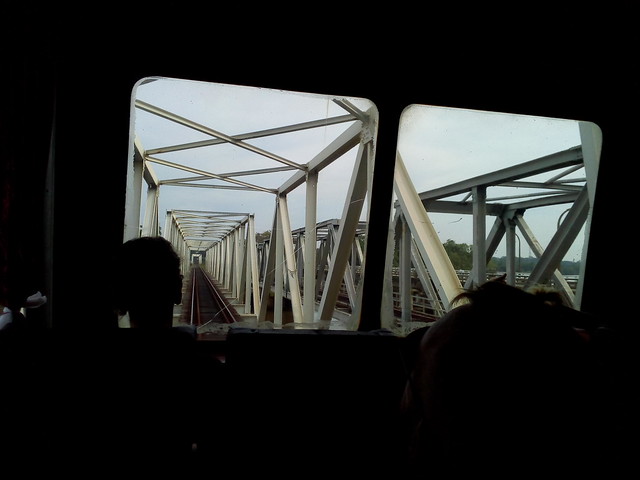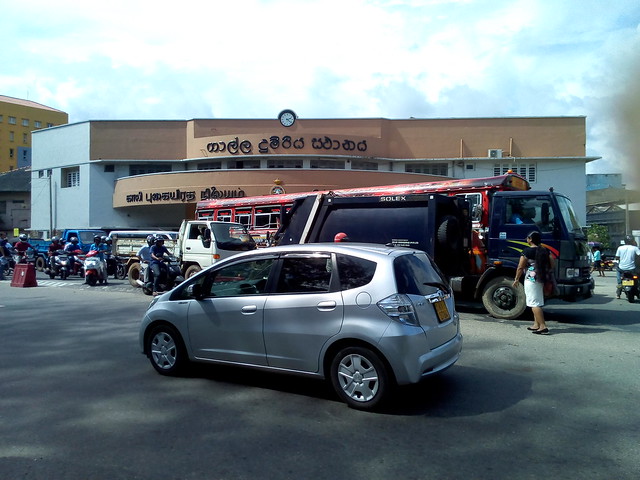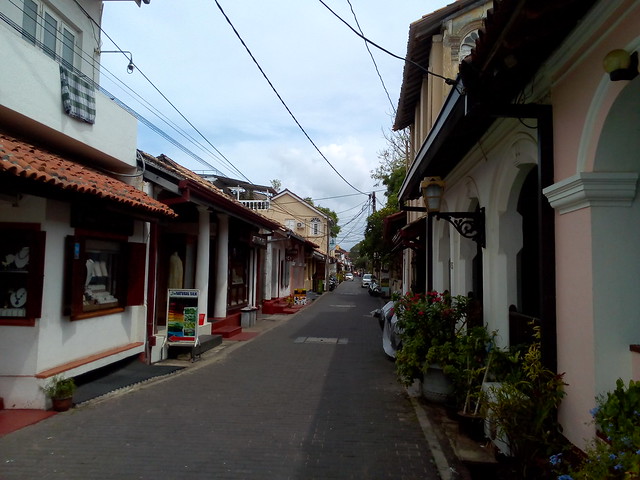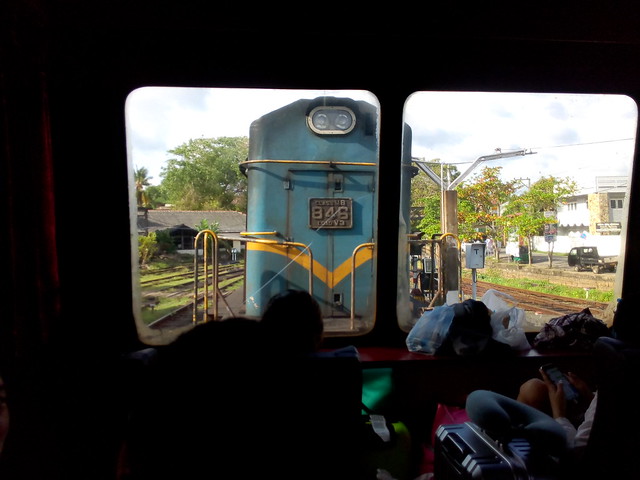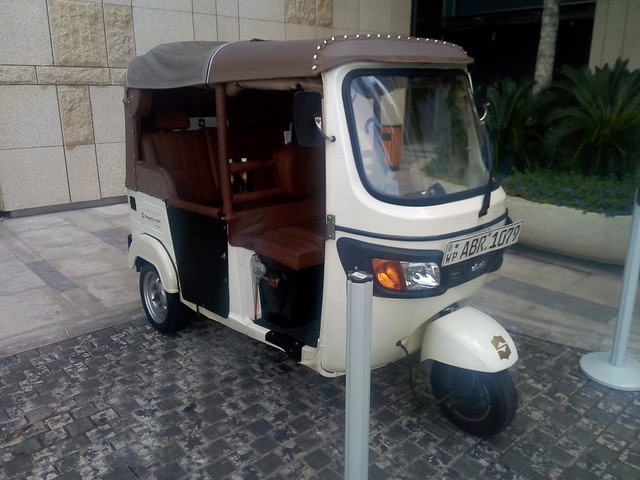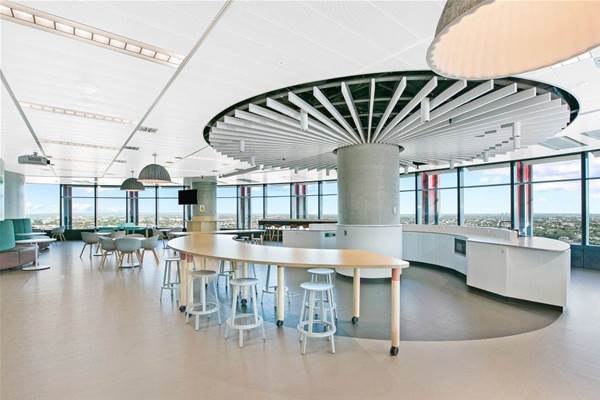The Australian Government is reported to be having negation difficulties with the French builder selected for the Collins Class submarine replacement. Perhaps it is time to consider not attempting to build very large bespoke submarines in Australia. Instead a smaller proven design could be ordered from an overseas shipyard, with recent experience in submarine building. Australian shipyards could instead build small submarine tenders to resupply these vessels.
Australia's unique requirement for a very long range conventionally powered submarine to transit from Australian ports meant that no proven designs were suitable. However, recently it was announced Australia and the USA would return to their former naval base on Manus Island, which is capable of operating submarines. Australia could complement the base with a small fleet of submarine tenders, based on the Arafura class multipurpose warship, or an Austral multi-hull design.
The small tenders could be fitted for the same modular mission payload system as the Arafura class. The tenders could dash at high speed to a suitable sheltered location to re-provision a submarine. The ships could be built in Australia in the shipyards currently building the Arafura class, meeting the political need for employment, as well as maintaining a shipbuilding capability.
Tuesday, December 11, 2018
Saturday, December 01, 2018
Repairing a RAAF Leather Flying Jacket
There were spots of lighter color, where the leather had worn, some holes in the cloth inside (just above the woven waistband), and the woven cuffs have frayed.
The color of the leather is officially described as "seal brown" (after the sea mammal, not the special forces). But Waproo Dark Brown Raven Oil is a reasonable match for this. I purchased a 50 ml bottle from a shoe repair kiosk, and dyed the shoulder straps, collar, front pockets and front zip flap. There was was only half a bottle left, so I decided to order online a 500 ml bottle. It turned out I only needed about 150ml for the whole jacket. This is a powerful dye, so it is important to keep it off the cloth lining (and anything else you do not want dark brown).
 The cuffs I repaired with a darning needle and dark brown DMC Stranded Cotton 3371.
The cuffs I repaired with a darning needle and dark brown DMC Stranded Cotton 3371.  The cloth lining was frayed just above the woven stretch cuff at the front bottom of the jacket, on each side, extending about 20 mm up. This is the point where my belt rubs on the inside of the jacket. I repaired it with a "fawn" iron-on patch (polyester cotton).
The cloth lining was frayed just above the woven stretch cuff at the front bottom of the jacket, on each side, extending about 20 mm up. This is the point where my belt rubs on the inside of the jacket. I repaired it with a "fawn" iron-on patch (polyester cotton). I cut the patch length-ways into four strips 23 mm wide. These I ironed onto the cloth lining inside each front side of the jacket, just above the stretch cuff. First I ironed one end of a strip to just next to the zipper, then stretched the jacket out, and kept it stretched while ironing the strip flat onto the fabric. When the patch cooled down I let go, and the fabric puckered around the stretch cuff. It took two overlapping strips to reach the side seam of the jacket. I did not patch the back of the jacket as there was no sign of wear.
The total cost was about $40, and should keep the coat looking good for a few more years.
Thursday, November 29, 2018
Privacy and the Future of the Web
 |
| Marcos Cáceres, W3C |
Monday, November 19, 2018
4G Wireless Broadband
Since 2008, I have been using a Huawei D100 3G Router with a USB wireless modem supplied by Virgin for travel.
The router is pocket size, with a slot to hold the modem and I have been powering it from USB on my laptop. But Virgin are discontinuing their mobile service in Australia. I only use a tiny fraction of the amount of data I am paying for, so it was time to look for a new plan.
My current USB modem is locked to Virgin, and I had no easy way to find the code needed to unlock it. So I purchased a Huawei E8372 from Australia Post (on special for $19.95). This is branded a Tesltra 4G USB+Wi-Fi 4GX modem. This device is a Wingle: Wifi equipped USB modem dongle.
I would have preferred a simple dongle I could plug into my existing router, but could not find one for sale. The Huawei E8372 has Wi-Fi and doesn't need an add-on router.
I tried signing up with the Telstra SIM which came already installed in the modem. However, Telstra did not have the address on my driver's license in their database, and while it appeared to accept my passport details, I never received a conformation e-mail and was not able to use the service.
Belong have plans with unlimited throttled data (at 64Kbps). That is, rather than being charged extra, or having the service suspended, as other providers do, Belong slow data to 64 Kbps. This looks useful for occasional lite use. So I tried a Belong SIM, but the modem then asked for an unlock code (despite Belong being owned by Telstra).
So I called Telstra for an unlock code. After going through a few automated steps I was put through to an operator who checked the IMEI number (from the back of the modem box: don't throw the box away). The unlocking cost $25, but curiously the operator would not accept payment over the phone. Instead I went to the Telstra website, paid the money and read them the receipt number. The operator then gave me the unlocking code, which I entered and which worked.
With the router unlocked I had to add a profile for Belong. The only change needed was APN: mdata.net.au.
The next problem was to activate the Belong SIM. The Belong instructions say to download an App, but this will not work with a Wingle. Eventually I found a button on the support website to "set up and connect your Belong mobile service". Belong's system had my address listed (which is odd as their parent company Telstra did not). Within a few minutes the account was activated and the Wingle working. Try saying that really fast. ;-)
The Wingle has advantages over a pocket router and dongle. The Wingle is much smaller and consumes one third the power (1 Watt, versus 3 Watts for a router and dongle). All the configuration settings are in the Wingle and it just needs power from a USB socket to operate (no configuration in the laptop is needed). However, the wingle is slightly fatter than the dongle and I can't use the adjacent USB socket, without using an extension cable.
Something I noticed was that when I plugged the Wingle into my laptop (running Mint Linux), it switched from WiFi to USB for data transfer. I did nothing to enable this switch, it happened automatically.
I also needed a wired Ethernet connection occasionally. The simplest way to provide this was a router configured in "Client Mode". I used a TP-LINK TL-WR802N Mini Router, connected to the modem via WiFi. This unit is matchbox sized, and comes with a short Ethernet cable, a USB cable for power and mains adapter. If I needed a permanent wired connection, I could have used a router with a USB socket for the modem (such as the TP-Link TL-MR3420).
ps: Several days after trying, and failing, to sign up with Telstra, I received an email "welcoming" me to their service. This is far too late. I have asked them not to send any more emails, as I am not their customer.
My current USB modem is locked to Virgin, and I had no easy way to find the code needed to unlock it. So I purchased a Huawei E8372 from Australia Post (on special for $19.95). This is branded a Tesltra 4G USB+Wi-Fi 4GX modem. This device is a Wingle: Wifi equipped USB modem dongle.
I would have preferred a simple dongle I could plug into my existing router, but could not find one for sale. The Huawei E8372 has Wi-Fi and doesn't need an add-on router.
I tried signing up with the Telstra SIM which came already installed in the modem. However, Telstra did not have the address on my driver's license in their database, and while it appeared to accept my passport details, I never received a conformation e-mail and was not able to use the service.
Belong have plans with unlimited throttled data (at 64Kbps). That is, rather than being charged extra, or having the service suspended, as other providers do, Belong slow data to 64 Kbps. This looks useful for occasional lite use. So I tried a Belong SIM, but the modem then asked for an unlock code (despite Belong being owned by Telstra).
So I called Telstra for an unlock code. After going through a few automated steps I was put through to an operator who checked the IMEI number (from the back of the modem box: don't throw the box away). The unlocking cost $25, but curiously the operator would not accept payment over the phone. Instead I went to the Telstra website, paid the money and read them the receipt number. The operator then gave me the unlocking code, which I entered and which worked.
With the router unlocked I had to add a profile for Belong. The only change needed was APN: mdata.net.au.
The next problem was to activate the Belong SIM. The Belong instructions say to download an App, but this will not work with a Wingle. Eventually I found a button on the support website to "set up and connect your Belong mobile service". Belong's system had my address listed (which is odd as their parent company Telstra did not). Within a few minutes the account was activated and the Wingle working. Try saying that really fast. ;-)
The Wingle has advantages over a pocket router and dongle. The Wingle is much smaller and consumes one third the power (1 Watt, versus 3 Watts for a router and dongle). All the configuration settings are in the Wingle and it just needs power from a USB socket to operate (no configuration in the laptop is needed). However, the wingle is slightly fatter than the dongle and I can't use the adjacent USB socket, without using an extension cable.
Something I noticed was that when I plugged the Wingle into my laptop (running Mint Linux), it switched from WiFi to USB for data transfer. I did nothing to enable this switch, it happened automatically.
I also needed a wired Ethernet connection occasionally. The simplest way to provide this was a router configured in "Client Mode". I used a TP-LINK TL-WR802N Mini Router, connected to the modem via WiFi. This unit is matchbox sized, and comes with a short Ethernet cable, a USB cable for power and mains adapter. If I needed a permanent wired connection, I could have used a router with a USB socket for the modem (such as the TP-Link TL-MR3420).
ps: Several days after trying, and failing, to sign up with Telstra, I received an email "welcoming" me to their service. This is far too late. I have asked them not to send any more emails, as I am not their customer.
Set the Direction of ICT for Australia
The Australian Computer Society (ACS) have issued a Call for Expressions of Interest for committees in 2019.
Nominations are open for the Profession Advisory Board and these committees:
Nominations are open for the Profession Advisory Board and these committees:
- Diversity and Inclusion Committee
- Artificial Intelligence Ethics Committee
- Blockchain Committee
- Data Sharing Committee
- Internet of Things Committee
- Ethics Committee
- ICT Educators Committee
- Accreditation Committee
Wednesday, October 24, 2018
Problems with IEEE Website Has Me Reconsidering Membership
I have been a member of the IEEE Computer Society for 34 years, but problems with renewing online this year make me wonder if it is an organization I want to be associated with.
When I tried to renew I got:
On my next attempt in Chrome, I got further, but then some images are not appearing. Instead of images I get:
So I went to the IEEE feedback page to report the accessibility problem. I filled in the form, but then got the error message:
When I tried to renew I got:
"Bad RequestThe IEEE support center suggested:
Your browser sent a request that this server
could not understand. Size of a request header
field exceeds server limit."
"... delete all the cache and cookies and refresh the browser and then access your IEEE account. Please use latest version of Google Chrome to access your IEEE account and the website works well on Chrome.".That worked, but shouldn't the website work with other browsers?
On my next attempt in Chrome, I got further, but then some images are not appearing. Instead of images I get:
"White check mark on TEAL background"From the context, I eventually worked out this must indicate "Yes", but that is what the ALT text should say. As it is the website doesn't conform to accessibility guidelines.
So I went to the IEEE feedback page to report the accessibility problem. I filled in the form, but then got the error message:
"⚠ Unsuccessful submission. Please enter the correct CAPTCHA value."But there is no CAPTCHA image displayed on the page and no alternative provided.
Monday, October 22, 2018
Colombo to Galle by Train Down the Coastal Line of Sri Lanka
A few weeks ago I traveled from Colombo to Galle along the Coastal Line of Sri Lanka. The line follows the coast for about 100 km, sometimes so close to the beach that you can feel the spray on your face.
To plan the trip I used Seat 61 and booked through Visit Sri Lanka Tours. The tickets were at the Colombo Fort ticket office, as promised. However, the office took some finding, as it is not in the main hall of the station (where the local ticket booths are), but through a door to the left (when facing the building) on the outside. There was no one at the Colombo-Galle-Matara window, so after a few minutes I tried the one next to that and got my ticket (it might have been better to pay extra and have the ticket delivered to my hotel). The next challenge was to find the right platform and car, in the early morning commuter rush.
After asking a few people I ended up in the right place. I had booked the 1st class observation car, which was "air-conditioned". The car was far from new and the air conditioning was an electric fan on the roof. But it was only one quarter full, and had a clean toilet, which is luxury on any form of Sri Lanaka transport. There was a large window on the end of the car (with one pane cracked), providing an excellent view of where we had been, plus opening widows on each side.
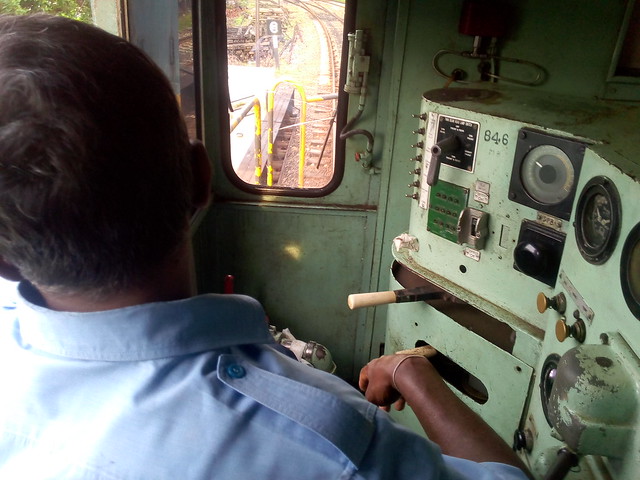 One problem is the large number of people bothering you. I had someone at my seat asking for a donation to an orphanage (chased off by the conductor). Someone in a blue shirt then asked if I would like to see in the locomotive. I thought this was yet another tout, but it turned out to be the driver. So I got to see the driving cab of the locomotive. I was worried this might distract the driver from preparations, but there was a second crew member in the cab.
One problem is the large number of people bothering you. I had someone at my seat asking for a donation to an orphanage (chased off by the conductor). Someone in a blue shirt then asked if I would like to see in the locomotive. I thought this was yet another tout, but it turned out to be the driver. So I got to see the driving cab of the locomotive. I was worried this might distract the driver from preparations, but there was a second crew member in the cab.
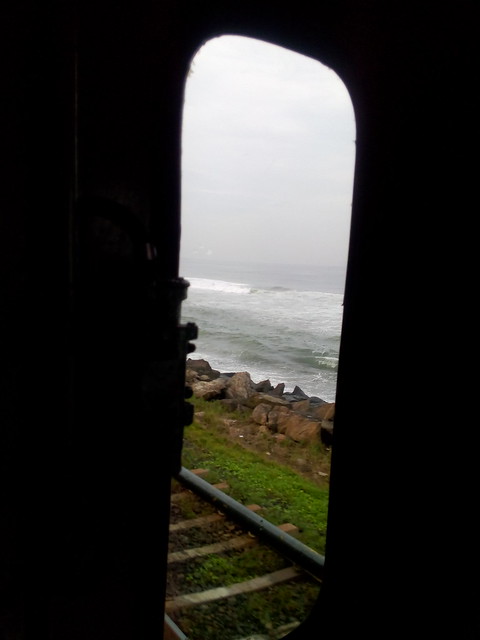 The track goes though the city in a cutting, then out to the beach, just past Galle Face Green. On one side is the coastal road and on the other the beach. There were people causally strolling across the track, as well as Tuk tuks. However, it is clear they know ever inch of the track, every bump (there are many) and where to expect problems.
The track goes though the city in a cutting, then out to the beach, just past Galle Face Green. On one side is the coastal road and on the other the beach. There were people causally strolling across the track, as well as Tuk tuks. However, it is clear they know ever inch of the track, every bump (there are many) and where to expect problems.
While the coast with villages and fishing boats is impressive, I was more interested in the rapid development evident on the landward side.
The passengers are mostly foreign tourists. There are the a few seasoned backpackers. One provided a running commentary which was a little disconcerting at times, pointing out this is the line with the worst rail disaster in world history, when the 2004 tsunami derailed a train.
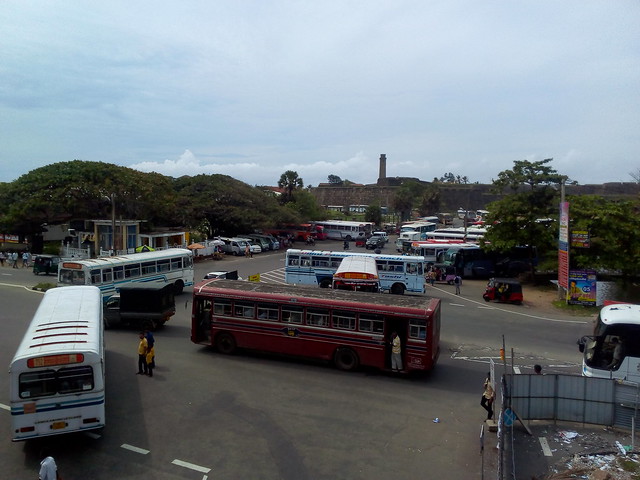 After a comfortable journey, the train arrived on time at Galle Station, an impressive slightly Art Deco looking building. Getting from the station across the busy road to Galle Fort proved difficult. I tried the foot-bridge over a creek to the bus terminus, but then could not find how to get across the road. Back across the footbridge and on the other side of the station I found a crossing. This lead to Darmapala Park, which has a bridge to the Fort, but I decided to take a shortcut along the road (dodging past the many parked buses).
After a comfortable journey, the train arrived on time at Galle Station, an impressive slightly Art Deco looking building. Getting from the station across the busy road to Galle Fort proved difficult. I tried the foot-bridge over a creek to the bus terminus, but then could not find how to get across the road. Back across the footbridge and on the other side of the station I found a crossing. This lead to Darmapala Park, which has a bridge to the Fort, but I decided to take a shortcut along the road (dodging past the many parked buses).
 Galle Fort is an impressive structure and large enough to spend a day wandering around. The Galle National Maritime Museum (also devastated by the 2004 Tsunami), provided a break from the heat. The building is almost as interesting as the exhibits, being part of the fort wall. I walked around getting blisters, while turning down numerous offers of Tuk Tuk rides.
Galle Fort is an impressive structure and large enough to spend a day wandering around. The Galle National Maritime Museum (also devastated by the 2004 Tsunami), provided a break from the heat. The building is almost as interesting as the exhibits, being part of the fort wall. I walked around getting blisters, while turning down numerous offers of Tuk Tuk rides.
After wandering around I had a quick drink in the hip little Old Railway Cafe, overlooking the station. It was then a short walk back to the station, where I bumped into the driver, who pointed out that his locomotive was changing ends and the observation car would be at the front.
The observation car's end window was now partly blocked by the locomotive. But there was still a good view to ether side. As we rattled along, there were twilight views of people fishing, boats on the beach, and fish for sale at town markets (so close I could smell them). Sitting next to me was a local, who introduced themselves as a guard on the Viceroy Special steam train tours, asking if I knew Scott McGregor.
Despite the twilight, and my entertaining companion, th the trip back was an uncomfortable two hours. The locomotive was belching diesel smoke. It might be a good idea making the trip one way, from Colombo to Galle by train, and come back another way.
As the train pulled into Colombo Fort there was a tropical downpour, and I got back to my hotel sopping wet. Outside my balcony there was a train going past. That makes for a complete day of train tourism in the tropics. ;-)
To plan the trip I used Seat 61 and booked through Visit Sri Lanka Tours. The tickets were at the Colombo Fort ticket office, as promised. However, the office took some finding, as it is not in the main hall of the station (where the local ticket booths are), but through a door to the left (when facing the building) on the outside. There was no one at the Colombo-Galle-Matara window, so after a few minutes I tried the one next to that and got my ticket (it might have been better to pay extra and have the ticket delivered to my hotel). The next challenge was to find the right platform and car, in the early morning commuter rush.
After asking a few people I ended up in the right place. I had booked the 1st class observation car, which was "air-conditioned". The car was far from new and the air conditioning was an electric fan on the roof. But it was only one quarter full, and had a clean toilet, which is luxury on any form of Sri Lanaka transport. There was a large window on the end of the car (with one pane cracked), providing an excellent view of where we had been, plus opening widows on each side.
 One problem is the large number of people bothering you. I had someone at my seat asking for a donation to an orphanage (chased off by the conductor). Someone in a blue shirt then asked if I would like to see in the locomotive. I thought this was yet another tout, but it turned out to be the driver. So I got to see the driving cab of the locomotive. I was worried this might distract the driver from preparations, but there was a second crew member in the cab.
One problem is the large number of people bothering you. I had someone at my seat asking for a donation to an orphanage (chased off by the conductor). Someone in a blue shirt then asked if I would like to see in the locomotive. I thought this was yet another tout, but it turned out to be the driver. So I got to see the driving cab of the locomotive. I was worried this might distract the driver from preparations, but there was a second crew member in the cab. The track goes though the city in a cutting, then out to the beach, just past Galle Face Green. On one side is the coastal road and on the other the beach. There were people causally strolling across the track, as well as Tuk tuks. However, it is clear they know ever inch of the track, every bump (there are many) and where to expect problems.
The track goes though the city in a cutting, then out to the beach, just past Galle Face Green. On one side is the coastal road and on the other the beach. There were people causally strolling across the track, as well as Tuk tuks. However, it is clear they know ever inch of the track, every bump (there are many) and where to expect problems.While the coast with villages and fishing boats is impressive, I was more interested in the rapid development evident on the landward side.
The passengers are mostly foreign tourists. There are the a few seasoned backpackers. One provided a running commentary which was a little disconcerting at times, pointing out this is the line with the worst rail disaster in world history, when the 2004 tsunami derailed a train.
 After a comfortable journey, the train arrived on time at Galle Station, an impressive slightly Art Deco looking building. Getting from the station across the busy road to Galle Fort proved difficult. I tried the foot-bridge over a creek to the bus terminus, but then could not find how to get across the road. Back across the footbridge and on the other side of the station I found a crossing. This lead to Darmapala Park, which has a bridge to the Fort, but I decided to take a shortcut along the road (dodging past the many parked buses).
After a comfortable journey, the train arrived on time at Galle Station, an impressive slightly Art Deco looking building. Getting from the station across the busy road to Galle Fort proved difficult. I tried the foot-bridge over a creek to the bus terminus, but then could not find how to get across the road. Back across the footbridge and on the other side of the station I found a crossing. This lead to Darmapala Park, which has a bridge to the Fort, but I decided to take a shortcut along the road (dodging past the many parked buses). Galle Fort is an impressive structure and large enough to spend a day wandering around. The Galle National Maritime Museum (also devastated by the 2004 Tsunami), provided a break from the heat. The building is almost as interesting as the exhibits, being part of the fort wall. I walked around getting blisters, while turning down numerous offers of Tuk Tuk rides.
Galle Fort is an impressive structure and large enough to spend a day wandering around. The Galle National Maritime Museum (also devastated by the 2004 Tsunami), provided a break from the heat. The building is almost as interesting as the exhibits, being part of the fort wall. I walked around getting blisters, while turning down numerous offers of Tuk Tuk rides.After wandering around I had a quick drink in the hip little Old Railway Cafe, overlooking the station. It was then a short walk back to the station, where I bumped into the driver, who pointed out that his locomotive was changing ends and the observation car would be at the front.
The observation car's end window was now partly blocked by the locomotive. But there was still a good view to ether side. As we rattled along, there were twilight views of people fishing, boats on the beach, and fish for sale at town markets (so close I could smell them). Sitting next to me was a local, who introduced themselves as a guard on the Viceroy Special steam train tours, asking if I knew Scott McGregor.
Despite the twilight, and my entertaining companion, th the trip back was an uncomfortable two hours. The locomotive was belching diesel smoke. It might be a good idea making the trip one way, from Colombo to Galle by train, and come back another way.
As the train pulled into Colombo Fort there was a tropical downpour, and I got back to my hotel sopping wet. Outside my balcony there was a train going past. That makes for a complete day of train tourism in the tropics. ;-)
Sunday, October 21, 2018
Real Store is Still a Good Place to Shop for a Watch
Recently I was in Singapore and decided to buy a watch. My decades old hand-me-down watch was making odd beeping noises, stopping occasionally and the batteries were getting hard to find. Also I wanted something smaller, and simpler.
 The watch I inherited has analog hands as well as a digital display, alarm, and calendar. Unfortunately the current fashion is for either simple analog dress watches, or complex, large chunky diver's style watches. The former lack the alarm function and the latter are large with lots of dials and numbers. I am not a diver or pilot and just wanted something small and simple: hands and one digital display.
The watch I inherited has analog hands as well as a digital display, alarm, and calendar. Unfortunately the current fashion is for either simple analog dress watches, or complex, large chunky diver's style watches. The former lack the alarm function and the latter are large with lots of dials and numbers. I am not a diver or pilot and just wanted something small and simple: hands and one digital display.
At the less extreme end of the diver's style watch is the Timex T41101 Expedition. This has a very readable analog clock-face and one small digital display. But it still has a bezel with markings around the outside, which has no practical function. This unit goes some way to integrating the digital display on the round clock-face, by making it curved.
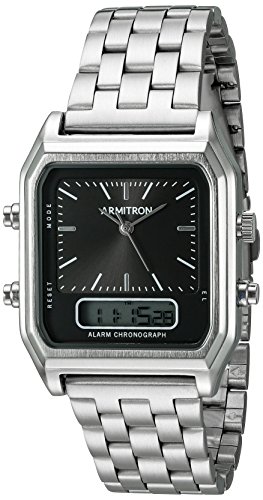
 There appear to be few simpler watches with a round format, perhaps because of the difficulty of integrating a a digital display. More common a rectangular watches. This gives them a slight antique look. A good example is the Pulsar PBK03. There is the similar, less expensive Armitron 20/5124BKSV, but this does not look quite as elegant and I am not familiar with the brand.
There appear to be few simpler watches with a round format, perhaps because of the difficulty of integrating a a digital display. More common a rectangular watches. This gives them a slight antique look. A good example is the Pulsar PBK03. There is the similar, less expensive Armitron 20/5124BKSV, but this does not look quite as elegant and I am not familiar with the brand.

 Both the Pulsar and Armitron have a crown for adjusting the watch hands. This makes them very quick to set, and is useful if you change time zones often. If you are willing to forego the crown and the sweep second hand, there are less expensive watches. The analog hands in these are set using a push button, which is much slower to use. An examples is the Casio AQ-230A. This watch is unusual, in that the case is plastic, but plated to look like stainless steel or gold in some models, with the back of the case and the band really are stainless steel. The Skmei by Autulet looks similar, but with a steel case. These watches are much cheaper than the Pulsar and Armitron and don't have luminous hands (the CASIO doesn't have a light for the digital display either).
Both the Pulsar and Armitron have a crown for adjusting the watch hands. This makes them very quick to set, and is useful if you change time zones often. If you are willing to forego the crown and the sweep second hand, there are less expensive watches. The analog hands in these are set using a push button, which is much slower to use. An examples is the Casio AQ-230A. This watch is unusual, in that the case is plastic, but plated to look like stainless steel or gold in some models, with the back of the case and the band really are stainless steel. The Skmei by Autulet looks similar, but with a steel case. These watches are much cheaper than the Pulsar and Armitron and don't have luminous hands (the CASIO doesn't have a light for the digital display either).
Another option I looked at were talking watches. These are intended for those with limited eyesight and use synthetic speech in place of the digital display. Unfortunately many of the more advanced models are designed to automatically set the time by a radio signal not available in Australia. The simpler Timechant 1267, doesn't need a radio signal.
However, a watch is difficult to choose, unless you have placed it on your wrist. So in Singapore I looked at the watches available. The first store I looked at in Orchard Road had prices displayed about four times those I had seen online, and after some haggling this came down to twice as much. I then found the 3D Watch Shop Singapore. They had a large range of stock and prices displayed about the same as online and I purchased the Casio AQ-230A.
 The watch I inherited has analog hands as well as a digital display, alarm, and calendar. Unfortunately the current fashion is for either simple analog dress watches, or complex, large chunky diver's style watches. The former lack the alarm function and the latter are large with lots of dials and numbers. I am not a diver or pilot and just wanted something small and simple: hands and one digital display.
The watch I inherited has analog hands as well as a digital display, alarm, and calendar. Unfortunately the current fashion is for either simple analog dress watches, or complex, large chunky diver's style watches. The former lack the alarm function and the latter are large with lots of dials and numbers. I am not a diver or pilot and just wanted something small and simple: hands and one digital display.At the less extreme end of the diver's style watch is the Timex T41101 Expedition. This has a very readable analog clock-face and one small digital display. But it still has a bezel with markings around the outside, which has no practical function. This unit goes some way to integrating the digital display on the round clock-face, by making it curved.

 There appear to be few simpler watches with a round format, perhaps because of the difficulty of integrating a a digital display. More common a rectangular watches. This gives them a slight antique look. A good example is the Pulsar PBK03. There is the similar, less expensive Armitron 20/5124BKSV, but this does not look quite as elegant and I am not familiar with the brand.
There appear to be few simpler watches with a round format, perhaps because of the difficulty of integrating a a digital display. More common a rectangular watches. This gives them a slight antique look. A good example is the Pulsar PBK03. There is the similar, less expensive Armitron 20/5124BKSV, but this does not look quite as elegant and I am not familiar with the brand.
 Both the Pulsar and Armitron have a crown for adjusting the watch hands. This makes them very quick to set, and is useful if you change time zones often. If you are willing to forego the crown and the sweep second hand, there are less expensive watches. The analog hands in these are set using a push button, which is much slower to use. An examples is the Casio AQ-230A. This watch is unusual, in that the case is plastic, but plated to look like stainless steel or gold in some models, with the back of the case and the band really are stainless steel. The Skmei by Autulet looks similar, but with a steel case. These watches are much cheaper than the Pulsar and Armitron and don't have luminous hands (the CASIO doesn't have a light for the digital display either).
Both the Pulsar and Armitron have a crown for adjusting the watch hands. This makes them very quick to set, and is useful if you change time zones often. If you are willing to forego the crown and the sweep second hand, there are less expensive watches. The analog hands in these are set using a push button, which is much slower to use. An examples is the Casio AQ-230A. This watch is unusual, in that the case is plastic, but plated to look like stainless steel or gold in some models, with the back of the case and the band really are stainless steel. The Skmei by Autulet looks similar, but with a steel case. These watches are much cheaper than the Pulsar and Armitron and don't have luminous hands (the CASIO doesn't have a light for the digital display either).Another option I looked at were talking watches. These are intended for those with limited eyesight and use synthetic speech in place of the digital display. Unfortunately many of the more advanced models are designed to automatically set the time by a radio signal not available in Australia. The simpler Timechant 1267, doesn't need a radio signal.
However, a watch is difficult to choose, unless you have placed it on your wrist. So in Singapore I looked at the watches available. The first store I looked at in Orchard Road had prices displayed about four times those I had seen online, and after some haggling this came down to twice as much. I then found the 3D Watch Shop Singapore. They had a large range of stock and prices displayed about the same as online and I purchased the Casio AQ-230A.
Monday, October 15, 2018
Battery Electric Tuk Tuk in Colombo
In early October I was in Sri Lanka to speak at the Computer Society of Sri Lanka (CSSL) National IT Conference (NITC 2018). The event was at the Shangri-La Hotel in Colombo, who provided guests with a ride in a battery-electric Tuk Tuk. This provides the excitement of a ride in one of these three wheel taxis, with more comfort and safety.
Saturday, October 13, 2018
New Port City Colombo
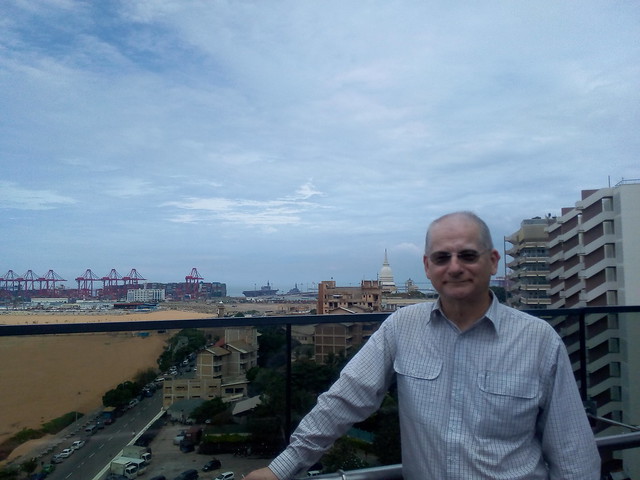 |
| Tom Worthington in Colombo |
The new city is intended to be in the style of Singapore. It will be interesting to see how this goes.
 |
| JS Kaga at Colombo |
Train past Galle Face in Colombo
 |
| View from Hotel Samudra Balcony |
The students line up outside each morning at 8am, in their perfect white uniforms for the raising of the national flag and anthem. This is not something you see in the average hotel. The rooms are large, with balconies overlooking the beach, but could do with some maintenance. The students are very keen to provide service, but are students. This was a very different atmosphere to an impersonal hotel.
The train from Colombo to Galle runs between the hotel and the ocean. This would be a delight for train spotters. Also the new Colombo port is visible in the distance, past Galle Face. On Friday night there were fireworks at the Galle Face, which I could almost reach out and touch.
Monday, October 01, 2018
Secured My Website with Let's Encrypt
I now have Let's Encrypt providing a free security certificate for my Tomw website. I am not doing any e-commerce transactions requiring high security, but it was annoying web browsers were issuing "Not Secure" warnings for my web pages, so I set about fixing this. The Cpanel system provided by my web hosting provider offered several for-fee certificates. Then I saw Let's Encrypt offering a free certificate. There was a lot of complex technical detail about how to get a certificate. Instead I asked my provider if they could do it and an hour later it was done. About the only difference is that you use HTTPS, rather than HTTP (with HTTP automatically redirected to HTTPS).
Tuesday, September 11, 2018
Sydney Technology Innovation Precinct
The NSW Government has set up a panel of experts, headed by David
Thodey, Jobs for NSW Chair, to produce a vision for a technology and innovation precinct in central
Sydney. The Sydney Technology Innovation Precinct will include Ultimo, Central Station, Redfern Station, Eveleigh Rail Yards, to Camperdown. This area includes University of Technology Sydney and the Australian Technology Park (ATP). This is a roughly rectangular area of about 7 square kilometers of the inner west of Sydney. The deadline for submissions is 10 September 2018.
In my closing address to the 1998 Information Industry Outlook Conference, in Canberra I proposed using the Cambridge model for Australian innovation precincts.This has now been done in Canberra, next to the ANU.
In my closing address to the 1998 Information Industry Outlook Conference, in Canberra I proposed using the Cambridge model for Australian innovation precincts.This has now been done in Canberra, next to the ANU.
EduTECH Asia in Singapore 8 to 11 October
EduTECH Asia is on
8 to 11 October
2018 at the Suntec Convention and Exhibition Centre in Singapore. I am speaking on Decreasing Campus Energy Use With Flexible Classrooms and e-Learning in the new EduBuild stream on 9 October and the next day taking part in a discussion of "Learning to use new tech-infused teaching spaces". There are also some free activities and exhibition.
Tuesday, September 04, 2018
ACS President Calls for Expansion of Australian Defence Industry
Following Mr Ramasundar, Dr Vikram Sharma, CEO of Quintessence Labs in Canberra, mentioned work being undertaken for the Australian Department of Defence on quantum key distribution for cryptography.
I will be speaking at the conference at 1:15pm, in the security stream, on m-Learning from Canberra for the Indo-Pacific and how this can complement China's Belt and Road Initiative.
Tuesday, August 21, 2018
The Unknown Unknowns of Computer Consulting
 |
Andrea Parsons |
Andrea undertakes engagements under a fixed price quotation. This starts with a scoping study to find the limits of the unknown unknowns. The quote includes an investigation and discovery step. The example given was of a new payroll system. The problem was, in essence, to get the client to understand how complex a problem this was.
Andrea emphasized the need to engage with stakeholders, avoiding "us" and "them". She pointed out the silliness of people sitting down the hall from each other, but communicating specifications by email.
What I found interesting about this is that many of the issues in software design are similar to those for educational design. In the courses MDDE 605: Planning and Management in Distance Education and MDDE 617 - Program Evaluation in DE, I had to plan a new educational initiative and in the latter prepare a quote for evaluation of an existing course. Presumably many other professions undertake these planning and estimation tasks.
Monday, August 13, 2018
Vale Brenda Aynsley
 |
| Brenda Aynsley, OAM FACS CP |
"It's with deep sadness that I let the Link community know that our dear colleague and friend of many years, Brenda Aynsley, passed away quietly this morning in Adelaide, after a long illness. Many here will know Brenda from different paths in the IT community, and those of us who were lucky enough as a true friend. I will miss her more than I can tell. There is to be no funeral, but if I get word of other wishes, I will pass them along."
From: Sad news - Vale Brenda, Jan Whitaker, Link list on Australian network policy and communications, 12 August 2018, 12:49:51As Brenda wrote on her LinkedIn entry, she was:
"... totally absorbed by and committed to the Internet and technology, not because of the nature of the toys and tools, but because both provide the means of facilitating effective communication between citizens of the world. ..."Her work was global, but I knew Brenda as a fellow member of many ACS committees, and one of my successors as ACS President. Brenda changed the direction of my professional work, as one of the team training myself, and others, to teach computer professionals (Lindley, Aynsley, Driver, Godfrey, Hart, Heinrich, Unhelkar & Wilkinson, 2013).
Brenda was most recently Chair on the ACS South Australia Branch, a relatively recent appointment from January 2018. She was also Convenor of the ACS SA PC Recycling Group, a position she had held for eighteen years. I visited her at the PC Recycling group and included this in my ICT Sustainability course.
Brenda Aynsley was as the first female President of the ACS, in 2013.
Brenda was recognized for service to the information and communications technology sector in the 2014 Australia Day Honours list, with an Medal of the Order of Australia (OAM). She was a Flinders University alumnus, being awarded a BA in 1982 and DipSocSc in 1984.
Brenda held so many positions in the computer profession in Australia and internationally, it would be difficult to list them all. Here are a few:
- Chair, International Professional Practice Partnership (IP3), International Federation for Information Processing.
- National Vice-President, Australian Computer Society, 2002-2003 and 2010-2011; Honorary Life Member, 2008.
- Chair, ACS National Community Engagement Board, 2009-2010.
- Chair, Ageism Task Force, 2010.
- Lead Tutor and Academic Program Coordinator, ACS Professional Year Program.
- Founding Member, Electronic Frontiers Australia, 1994.
- Honorary Secretary, South Australian Branch, Australian Computer Society; Chairman, 1999-2001, 2004-2006 and 2018; ACS Member, since 1989; Founder and Manager, ACS PC Recycling Group, since 2000.
- Chair, SA Committee, The Pearcey Foundation, 2006-2012.
- Opened South Australia's first Internet Café, 1995.
Founding Member, South Australian Internet Association, 1995. - Fellow, South Australian Branch, Australian Computer Society, 2003.
Reference
Lindley, D., Aynsley, B., Driver, M.,
Godfrey, R., Hart, R., Heinrich, G., ... & Wilkinson, K. (2013). 11.
Educating for professionalism in ICT: Is learning ethics professional
development?. Professionalism in the information and communication technology industry, 211. URL http://press-files.anu.edu.au/downloads/press/p223541/html/ch11.xhtml?referer=37
Tuesday, July 31, 2018
Will the NEG transform Australia's energy landscape?
Greetings from the Australian National University in Canberra, where a panel is speaking on "Will the NEG transform Australia's energy landscape?".
First up is Mr Shane Rattenbury, ACT Minister for Climate Change and Sustainability. Minister Rattenbury was one of the recipients of a letter today, from 23 energy researchers: "Call for Full Release of National Energy Guarantee Modelling". He pointed out that the National Energy Guarantee (NEG) will not reduce emissions significantly more than "business as usual". Also there will be a considerable number of coal plants reaching their design life just after 2030, requiring to be replaced.
Also to speak are Professor Frank Jotzo (Crawford School of Public Policy, ANU), Dr Hugh Saddler (energy consultant) and Ms Katharine Murphy (Political Editor, Guardian Australia).
ps: Professor Jotzo and Dr Saddler agreed that the NEG was not a lot better than "business as usual". Katharine Murphy, looking at the political aspects, suggested the NEG could be useful, not because it achieves any fundamental reform, but primes the political process for something more ambitious.
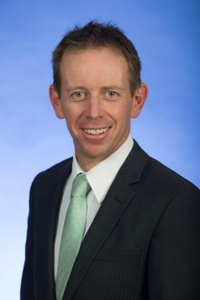 |
| Shane Rattenbury |
Also to speak are Professor Frank Jotzo (Crawford School of Public Policy, ANU), Dr Hugh Saddler (energy consultant) and Ms Katharine Murphy (Political Editor, Guardian Australia).
ps: Professor Jotzo and Dr Saddler agreed that the NEG was not a lot better than "business as usual". Katharine Murphy, looking at the political aspects, suggested the NEG could be useful, not because it achieves any fundamental reform, but primes the political process for something more ambitious.
Wednesday, July 25, 2018
Blockchain: What is it good for?
Greetings from the Australian Computer Society's new headquarters in Sydney. I am taking part in a workshop, as a member of the ACS Blockchain Committee. It is a little hard to focus on the details of what advice we should provide Australian government, industry and community on the how and why of blockchain, due to the view. The new ACS office is on the 27th floor of a building on the Sydney waterfront, with panoramic views all the way to the Blue Mountains.
Getting back to the workshop, ACS has published a series of articles on blockchain. We have a mix of technologists, lawyers and industry people in the room, working out what the issues are. As an example, what are the issues in using blockchain in education?
Getting back to the workshop, ACS has published a series of articles on blockchain. We have a mix of technologists, lawyers and industry people in the room, working out what the issues are. As an example, what are the issues in using blockchain in education?
Sunday, July 15, 2018
Uluru Statement from the Heart on Wikipedia
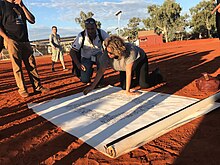 |
| Denise Bowden, signing the Uluru Statement, in Central Australia. |
"... We seek constitutional reforms to empower our people and take a rightful place in our own country. ...".
Thursday, July 05, 2018
Katharine Murphy On Disruption
Greetings from the Australian National University, where Michelle Grattan is asking Katharine Murphy about her new book "On Disruption".
This is a short 121 page, A6 size pocket book, which is very readable. This is a bit Zen and the Art of Motorcycle Maintenance, being in part a personal reflection on becoming a journalist and part on the nature of political discourse in the age of the Internet. It starts "It was the fag end of summer and I was decked out in a new linen threepiece suit from Sportscraft."
Michelle Grattan asked about the story of the week with Senator Leyonhjelm's comments about Sarah Hanson-Young. Katharine Murphy commented that women have decided not to accept such comments any more.
One question from the audience is where does the money come from. Katharine Murphy replied that The Guardian has a membership scheme, rather than a pay-wall. This is curious as in effect, the for-profit company takes donations like the pay-what you can Lentil as Anything
restaurant in Sydney.
The thesis of the book is that the Internet has "disrupted" journalism, in the same way Uber disrupted taxis. The problem is not knowing where all the information "washing around" the Internet came from "... perhaps someone in a basement in Moldavia".
What I find surprising is that journalists did not realize the Internet was going to disrupt their business until it happened. Hopefully the academics in the audience are listening, as the Internet is coming to disrupt them.
Last month the "Father of the Internet", Vint Cerf, talked at the Australian National University in Canberra. Australia has had Internet access for thirty years, about ten years after the US development.
This is a short 121 page, A6 size pocket book, which is very readable. This is a bit Zen and the Art of Motorcycle Maintenance, being in part a personal reflection on becoming a journalist and part on the nature of political discourse in the age of the Internet. It starts "It was the fag end of summer and I was decked out in a new linen threepiece suit from Sportscraft."
Michelle Grattan asked about the story of the week with Senator Leyonhjelm's comments about Sarah Hanson-Young. Katharine Murphy commented that women have decided not to accept such comments any more.
One question from the audience is where does the money come from. Katharine Murphy replied that The Guardian has a membership scheme, rather than a pay-wall. This is curious as in effect, the for-profit company takes donations like the pay-what you can Lentil as Anything
restaurant in Sydney.
The thesis of the book is that the Internet has "disrupted" journalism, in the same way Uber disrupted taxis. The problem is not knowing where all the information "washing around" the Internet came from "... perhaps someone in a basement in Moldavia".
What I find surprising is that journalists did not realize the Internet was going to disrupt their business until it happened. Hopefully the academics in the audience are listening, as the Internet is coming to disrupt them.
Last month the "Father of the Internet", Vint Cerf, talked at the Australian National University in Canberra. Australia has had Internet access for thirty years, about ten years after the US development.
Sunday, July 01, 2018
IT Changes Everything in Sri Lanka
I am scheduled to speak at the National IT Conference in Sri Lanka (NITC 2018), 2 to 4 October 2018, organized by the Computer Society of Sri Lanka
(CSSL). The theme of the conference is: IT Changes Everything.
To help me prepare a presentation, the conference organizers have provided some references as background, from which I have extracted some quotes:
Development of Sri Lanka’s digital economy strategy
"Work on the country’s digital economy strategy has begun with input from world-renowned consultancy firm McKinsey, the Prime Minister’s Policy Development Office said yesterday. ..."
From: "Work begins on Sri Lanka’s digital economy strategy with McKinsey input", Daily FT, 8 January 2018Sri Lanka’s Digital Economy Strategy
Sri Lanka Vision 2025"... This initiative will strategize the promotion of the Digital Economy through the lens of three economic development thrust sectors, namely, agriculture sector, tourism sector and the manufacturing sector. It is expected that each of the sectors identified above will could develop at least one flagship programs to support this initial stage of Sri Lanka’s Digital Economy Strategy. ..."From "Sri Lanka’s Digital Economy Strategy", Department of Government Information, Sri Lanka, 7 January 2018
"The country needs to develop strategies that encourage the use of digital and other emergent technologies to become globally competitive and to drive the nation towards a digitally empowered economy. Enhanced digital ecosystems, through reduced transactions costs, will stimulate inclusive growth and job creation, especially by empowering the self-employed and SMEs.
... Sri Lanka’s IT literacy rate was a meagre 27.5% in 2016, with only 15.1% of households with internet access. The technology service sector has long been dominated by ICT, and there is little focus on promoting disruptive innovation technologies such as artificial intelligence (AI), data mining and other high-quality technological services. The economy needs a shift towards innovative, knowledge based business ventures.
- We will put in place a plan of action to encourage the transfer of appropriate foreign technologies into Sri Lanka. ...
- We will actively promote private sector investment in digital technology. Incentives to support emerging industries in robotics, cybernetics, and electronics will be provided. We will support development in advanced technology by encouraging education institutions to link up with the private sector. To improve market access for startups, we will facilitate the convergence of multiple technologies and integration with global startup networks. We will encourage the private sector to plan early for future workplaces, commerce, and manufacturing in the digital era. ...
- We will incentivise private sector investment in the ICT industry. ...
- We will integrate ICT literacy into school curricula. ...
- We will increase free Wi-Fi provision and increase incentives provided to widen internet access. ...
- We will continue the national digital identity initiative. ...
- We will increase digitalisation of Government operations. ...
- We will strengthen ICT based marketing interfaces. ...
- We will encourage innovations in mobile payment systems and peer-to-peer lending
platforms with necessary oversight. ...- We will strengthen Sri Lanka’s National Intellectual Property Office to manage
registration exploitation, regulation and resolution more effectively. ...- We will strengthen the legal framework for electronic transactions. ..."
From Chapter 9, Technology and Digitalization, "Vision 2025: A Country Enriched", Ministry of National Policies and Economic Affairs, Sri Lanka, 31 August 2017 (numbering of proposals added).
Questions
I was then asked to:
"1. Outline your topic and it's relevancy in-line of the overall theme of "IT changes everything"2. How do we drive a digital economy? What should be the key measurements? Timelines?3. What changes are needed at different levels of the society? E.g. how do you propose we change the current education system?4. What are you looking forward to during you planned visit to Sri Lanka during early October for NITC?
5. Any other info you think which is important."
Discussion
Framing the digital strategy for a nation is too much for one conference presentation. As an educator, I will naturally focus on education. The area I have been looking at in Australia and for the Asian region in my graduate studies has been vocational education. How do we bridge upper schooling, vocational colleges and university?
What are you looking forward to?
The easiest question to answer is "What are you looking forward to during you planned visit to Sri Lanka...". On my previous visit I enjoyed meeting people from the local IT industry and educational institutions. Highlights were a visit to a higher education institution which has connections to Australia and a IT company campus (where I gave a talk on emergency management using the Internet).
Wednesday, June 27, 2018
Australia’s Digital Pulse
Greetings from Parliament House in Canberra, where Michael Keenan, Minister Assisting the Prime Minister for Digital Transformation, launched the Australian Computer Society's Digital Pulse Report. Mr Keenan pointed out that IT was a global industry and taxes needed to be low or companies would move elsewhere. He also mentioned the government was changing IT procurement to allow smaller companies to tender. Interestingly, the report was prepared by Deloitte with help from LinkedIn:
ps: I was last at Parliament House on 4 June to speak to the Senate Committee on the Future of Work and Workers. I suggested changes to the education system to better address changes due to technology.
"With domestic graduates from ICT degrees still below 5,000 a year, the only way we’ll reach workforce targets is by importing labour, much as we’ve done for the past five years. We need more ICT workers with skills in artificial intelligence,
data science, cyber and blockchain, and filling these positions with migrants suggests a missed opportunity to provide rewarding employment for the next generation of Australian workers. Further, our existing workforce has diversity issues: only 28% of ICT workers are women and only 12% are over 55, compared with 45% and 15% in all professional industries respectively."
From "ACS Australia’s Digital Pulse", Deloitte and ACS, 27 June 2018My colleagues at ANU are teaching artificial intelligence, data science, cyber security and blockchain. The diversity issue is one which will perhaps be addressed by changes in university programs generally, and STEM ones in particular, to include more work relevant skills. This sees computer professionals having to learn people skills, and as a byproduct makes the courses more inclusive.
ps: I was last at Parliament House on 4 June to speak to the Senate Committee on the Future of Work and Workers. I suggested changes to the education system to better address changes due to technology.
Thursday, June 21, 2018
False Alarm from Indian Tsunami Early Warning Centre
Thursday morning I noticed a worrying message from the Indian Tsunami Early Warning Centre:
As confirmed later, this was a test message which escaped from the internal system, out to the public:
Date: Thu, 21 Jun 2018 03:29:03 +0530 ...
"IOTWMS-TSP INDIA has detected an earthquake with the following preliminary information:
Magnitude : 8.5 M
Depth : 10 km
Date : 20 JUN 2018
Origin Time: 2154UTC
... this earthquake may be capable of generating a tsunami affecting the Indian Ocean region."This was alarming because an 8.5 magnitude earthquake is extremely large. But then I noticed the location was given as "TEST_TEST_CENTRAL CHILE".
As confirmed later, this was a test message which escaped from the internal system, out to the public:
"CANCELLATION MESSAGE ...
Date: Thu, 21 Jun 2018 05:33:31 +0530
IOTWMS TSUNAMI SERVICE PROVIDER INDIA (ITEWC)
This is not a real event. This event was issued due to an operator error during an internal test. ..."It took two hours to issue the correction, which is an unacceptably long time.
Sunday, June 10, 2018
August Osage County at the New Theater Newton Sydney
The play August: Osage County at the New Theater, Newton Sydney, last night was like many family gatherings you have been to, combined with The Big Chill. Adult children gather at the family home after many years, due to a family tragedy. They argue with each other, and their partners, over the same old things, with long buried secrets emerging. At more than three hours, with two intervals, this is a long play, but worth staying to the end.
The Australian cast did a good job with mid-western US accents. Alice Livingstone had fun with the role of slightly mad matriarch.
I did not understand why playwright Tracy Letts inserted a native American into the middle of this play. Emilia Stubbs Grigoriou, gave a credible performance with little dialogue to work with, but passing comment on all happening around her through expression.
The set design by Sallyanne Facer was a little bare for a lived in family home. Also I found the red LED displays on the theater lighted overhead a little distracting.
The Australian cast did a good job with mid-western US accents. Alice Livingstone had fun with the role of slightly mad matriarch.
I did not understand why playwright Tracy Letts inserted a native American into the middle of this play. Emilia Stubbs Grigoriou, gave a credible performance with little dialogue to work with, but passing comment on all happening around her through expression.
The set design by Sallyanne Facer was a little bare for a lived in family home. Also I found the red LED displays on the theater lighted overhead a little distracting.
Friday, June 01, 2018
Australia Declares Cyberwar
The Australian Strategic Policy Institute (ASPI) and Australian Computer
Society (ACS) today released a national
cyberwarfare deterrence policy paper (Painter, 2018). The policy advocates unilateral reciprocity for cyber-attacks on Australia.
The report quotes Australia’s International Cyber Engagement Strategy:
Deterrence in cyberspace - Spare the costs, spoil the bad state actor: Deterrence in cyberspace requires consequences, Chris Painter, Australian Strategic Policy Institute Limited, 1 June 2018.
The report quotes Australia’s International Cyber Engagement Strategy:
"[h]aving established a firm foundation of international law and norms, the international community must now ensure there are effective consequences for those who act contrary to this consensus."However, the Painter doctrine is more in line with the US strategy of promising "swift and costly consequences", saying:
"... every country has the right to act to defend itself, but, if possible, acting together, with each country leveraging its capabilities as appropriate, is better. Collective action doesn’t require any particular organised group ...".The Australian Public Service Commission (APSC) has issued a draft learning design standard, detailing the knowledge required for government cyber security specialists. Civilian specialists working for government may well find themselves involved in offensive operations. The ANU offers a course in Cyber Offensive Security Operations as part of a Master of Cyber Security, Strategy and Risk Management. To address the ethical issues with being involved in such operations I have run students through a hypothetical on Cyberwar over the South China Sea.
Reference
Deterrence in cyberspace - Spare the costs, spoil the bad state actor: Deterrence in cyberspace requires consequences, Chris Painter, Australian Strategic Policy Institute Limited, 1 June 2018.
Wednesday, May 30, 2018
Green ICT in the Mauritius Declaration on Digitalisation and Sustainable Tourism
The "Mauritius Declaration on Digitalisation and Sustainable Tourism", adopted last week, includes a section on "Green ICT".
"7. to consider the rigorous application of “Green ICT” techniques to ensure minimal environmental impact being given that a connected world together managing the resulting data will in itself impose an environmental load;"Nations are welcome to make use of my "ICT Sustainability" course materials. I would be delighted to have an excuse to visit tropical islands to discuss it. ;-)
Tuesday, May 29, 2018
Green Climate Fund for Development
 Greetings from the Australian national University in Canberra, where Howard Bamsey, Executive Director of the Green Climate Fund is speaking on "The Green Climate Fund, climate finance, and the imperatives and pathways for global transformation". He started by pointing out the developed nations committed to "mobilize" $100B a year for developing nations actions on climate change by 2020. What "mobilize" means I am not sure. The DFAT "Roadmap to US$100 Billion" (2016) says "effectively mobilize private finance".
Greetings from the Australian national University in Canberra, where Howard Bamsey, Executive Director of the Green Climate Fund is speaking on "The Green Climate Fund, climate finance, and the imperatives and pathways for global transformation". He started by pointing out the developed nations committed to "mobilize" $100B a year for developing nations actions on climate change by 2020. What "mobilize" means I am not sure. The DFAT "Roadmap to US$100 Billion" (2016) says "effectively mobilize private finance".reetings from the Australian National University in Canberra, where
Ambassador Bamsey pointed out that the cost of PV solar power had dropped making it economic for use in developing nations. Also he pointed out that green bonds had taken off and the link to Islamic Finance. In 2008 I attended the Malaysian Corporate Governance Conference at the Securities Commission, Kuala Lumpur, the regulator for Islamic capital markets in Malaysia and noticed this link.
The IEA has a "Tracking Clean Energy Progress" page, which Ambassador Bamsey pointed to. He used the example of technology incubators as one initiative (but I am not sure who's or for what). He suggested that most investments are on mitigation and more is needed on adaption for the most vulnerable.
Ambassador Bamsey suggested that China has taken an engineering approach to climate change as the government is full of engineers (whereas the Australian Government is full of lawyers and economists).
This all seemed very general, so I asked for examples of investments and how much carbon emission, or other benefits resulted. This was perhaps because I spent the morning marking ICT Sustainability assignments from my students, where they had to say what improvement their proposals were expected to make.
Unfortunately while promising to get specific, Ambassador Bamsey would not say how much the Green Climate Fund had invested or how much mitigation and adaption this was expected to produce. Not everything can be reduced to a few numbers, but if the world is investing $100B a year, then it would be good to have some idea it was effectively spent. Also worrying is that fund is expected to run out money to invest by the end of the year. Interestingly the ACT Government is working on channeling private investment to the fund, however as a potential investor I would want to know what environmental and social return on investment I will get.
Saturday, May 26, 2018
Father of the Internet in Canberra
Internet pioneer Vint Cerf, will speak on "The future of the Internet" at the Australian National University in Canberra, 26 June 2018. For an understanding of the way the Internet was envisioned, I recommend Carl Malamud's 1992 book "Exploring the Internet: A Technical Travelogue", in which he reports on discussion with Vint Cerf and Australian Internet pioneer Geoff Huston.
I stumbled across Vint and Geoff in Stockholm during the Internet Society 2001 Conference. I went through the wrong door and interrupted a meeting deciding global domain name services. Geoff looked up and said "Hi Tom", when I saw Vint and just about everyone else running the Internet in the world, I turned and fled. ;-)
"Vint Cerf will explore areas where serious technical and policy efforts are needed to reinforce the utility of the Internet and diminish some of the harmful behaviors we are seeing. Some of the work will require transnational cooperation. Some solutions have much to do with educating users about protecting themselves when online and thinking critically about content. Technical improvements in software production will help, as will better security tools and practices. Vint will finish up with some speculations about the arc of the Internet as we get to the mid-2000s.
Vint will be coming to Australia as a featured speaker at the ANU Crawford Leadership Forum, 24-26 June 2018."
Thursday, May 24, 2018
How one computer salesman contributed to the digital revolution
Last
night I sat down next to someone who looked familiar at a university
talk. This being a university, they turned out to have a PhD, be an
author of a book and pioneer in the computer industry. Dr Christopher B. Yardley, is author of "ALSO INNOVATORS: How one computer salesman contributed to the digital revolution"
(2016). The full text is available free online from ANU Press. The
technology mentioned will sound like ancient history to computer
professionals today. But the problems of introducing new technology are
still current.
Contents of Also Innovators
- ‘A proper job’
- Once were cowboys
- A working ‘home away from home’
- A taste of Northern bitter
- Eddie French’s rainbow
- The brewer’s assistant
- Pursuing my own rainbow’s end
- The tallyman and other endeavours
- Adventures in Southeast Asia
- As far south as we could go
- Working with the airlines in the Australasia-Pacific region
- The ups and downs of a contractor
- Not a multinational this time
- A swansong working with the public service
Subscribe to:
Comments (Atom)
_-_1.jpg/450px-USNS_Spearhead_(JHSV-1)_-_1.jpg)





